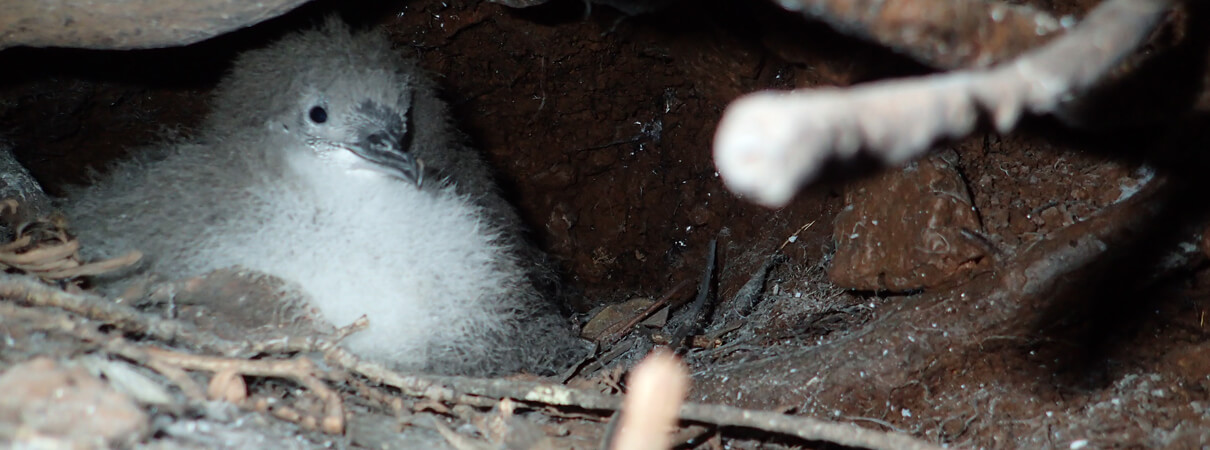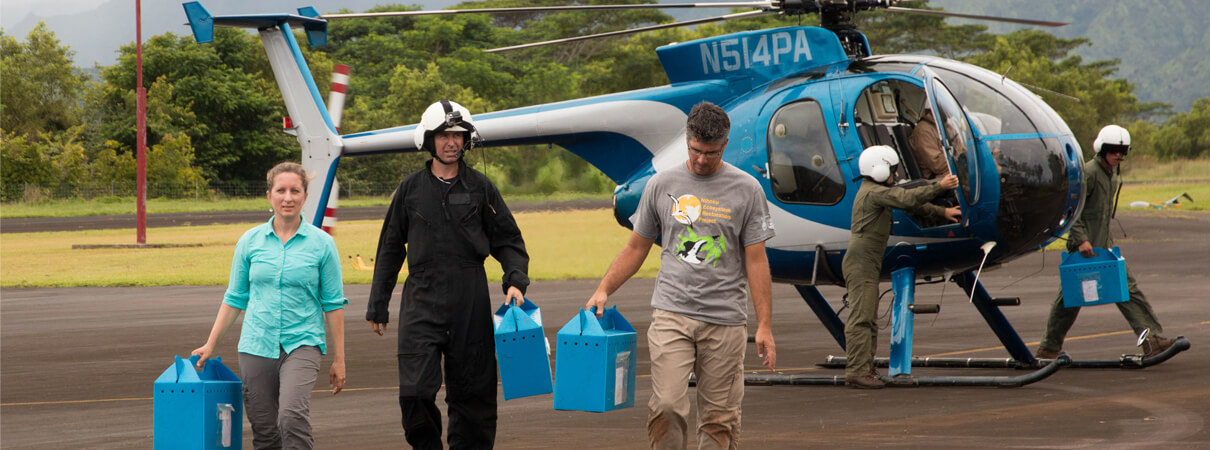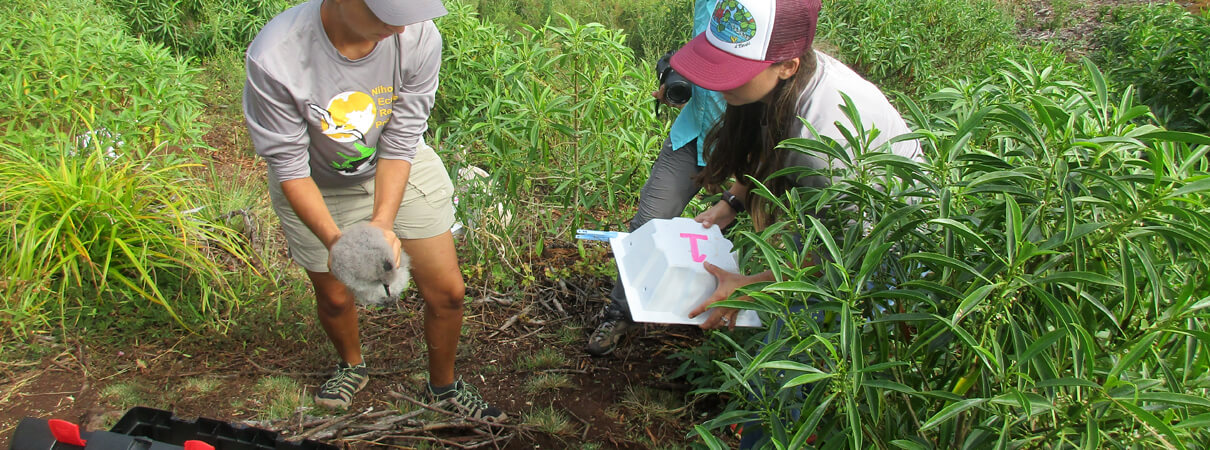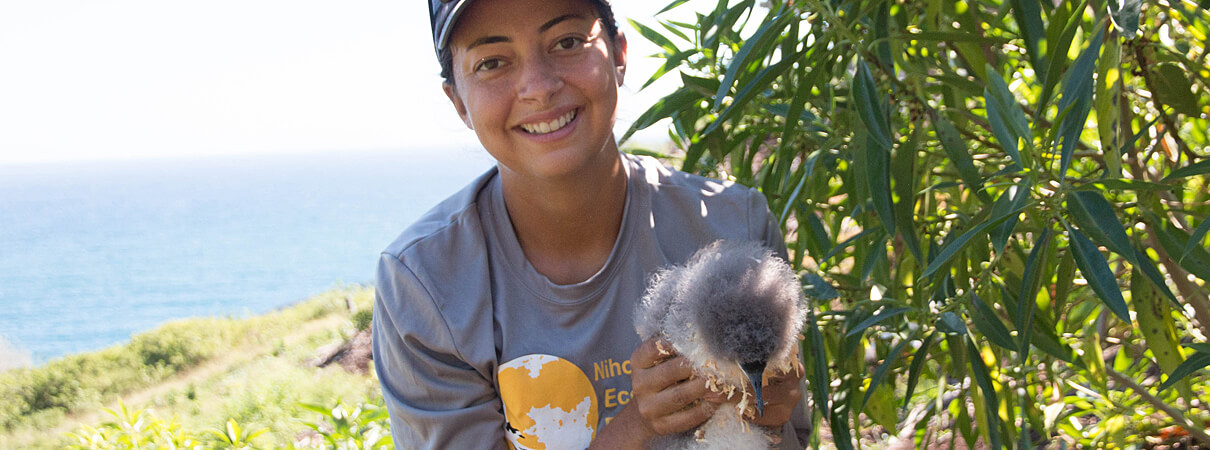New Colony of Chicks Keeps Hope Alive for Rare Newell's Shearwater
Sometimes you have to move it to save it. That's the theory behind a bold approach to bird conservation that has gained traction in Hawai‘i. Faced with steep declines among native seabirds, including Newell's Shearwater and Hawaiian Petrel, conservationists have translocated seabird chicks to a new, predator-proof colony for the second year in a row.
Last year, American Bird Conservancy and its Hawai‘i-based partners successfully moved 10 Hawaiian Petrels to a protected site at Kilauea Point National Wildlife Refuge. Last month, it was the turn of eight threatened Newell's Shearwater (‘A‘o) chicks to be flown by helicopter from their montane nesting areas to their new home at the refuge. Both species are endemic to Hawai‘i and found nowhere else in the world.

A Newell's Shearwater chick in its mountain burrow. Photo by André Raine, Kaua‘i Endangered Seabird Recovery Project
It's the first translocation of Newell's Shearwater chicks ever undertaken. But the translocation of chicks of closely related seabird species has been used with success in New Zealand to create new colonies, and a previous translocation of Newell's Shearwater eggs in the 1970s founded a small colony at the same refuge. Conservationists hope to achieve similar successes on Kaua‘i, having already begun to test the chick-translocation technique last year.
Helicopters and Fish Slurry
This year's translocation, which involved two separate teams and more than a dozen people, took place in Kaua‘i's rugged mountain interior and along the coast. Early on a September morning, a helicopter dropped a team onto a mountain peak located in the Upper Limahuli Preserve owned by the National Tropical Botanical Garden. The team members headed out to seven different nest burrows that had been monitored throughout the breeding season. They carefully removed seven large, healthy Newell's Shearwater chicks from their burrows by hand, placed them into pet carriers, and carried them up the side of the mountain to a waiting helicopter.
The chicks were flown to the Princeville airport, then driven to the refuge and their new home within the predator-proof fence. An eighth chick, rescued from another site in Hono o Na Pali Natural Area Reserve earlier in the season, soon joined the other seven at Kilauea Point.

Transporting the Newell's Shearwater chicks from the Princeville airport to their new home. Photo by Lindsay Young/Pacific Rim Conservation
So far the young birds appear to be adjusting nicely to their big move, says Dr. Lindsay Young, the project coordinator with Pacific Rim Conservation, one of several partners that made this project possible. The chicks are being hand-fed a slurry of fish and squid, and their growth has been carefully monitored.
“They are doing well and are gaining weight,” Young says. Many of the birds are ready to fledge; as of Monday, four have already flown away from their burrows, headed out to sea.
The Night Sky of Home
Like Hawaiian Petrels, Newell's Shearwater chicks imprint on their birth colony location the first time they emerge from their burrows and see the night sky; as adults, they will return to breed at the same colony. Since these chicks were removed from their natural burrows before that critical imprinting stage, it's hoped that they will emerge from their artificial burrows, imprint on the new colony, and return there as adults after three to five years at sea.
The new colony will be the only fully protected colony of this species anywhere in the Hawaiian Islands—an enormous step toward recovering this rare seabird.

A chick is placed in its new burrow. Photo by Hannah Nevins
“We are very excited to have accomplished a major recovery objective for one of Hawai‘i's endemic seabird species,” Young said. “What we learn on this project will be crucial to implementing what we hope will be many more projects like this on Kaua‘i and across the state.”
New Home for Newell's Shearwater
Threatened Newell's Shearwater is one of two seabird species endemic to the Hawaiian Islands. (The shearwaters' low, moaning call gave them their local name, 'A'o.) They have declined dramatically due to a number of factors, including predation by non-native species (such as cats, rats, pigs and Barn Owls) and collisions with man-made structures during nocturnal flights from their breeding colonies in the mountains to the ocean, where they search for food.
The chicks' new home at Nihoku is designed to keep them safe during this vulnerable stage of their lives. It also provides a safe site for them to return to and nest as adults. Surrounded by fine mesh stainless-steel fencing, the 7.8-acre enclosure protects the birds from predators and has been partially restored with native vegetation.

A predator-proof fence protects the chicks' new home at Nihoku. Photo by Hannah Nevins
“We are hopeful that translocation of this first group of chicks will mark the turning point in the downward trend for this species,” said Hannah Nevins, Director of American Bird Conservancy's Seabird Program. “The future of the Newell's Shearwater on Kaua‘i is dependent on multiple actions, from colony protection in the mountains to creating new predator-free colonies with fences, and continuing to mitigate light and collision impacts.”
“Kaua‘i is home to an estimated 90 percent of the world population of Newell's Shearwater, so the island really is critical to the long-term survival of this species,” said Dr. André Raine of Kaua‘i Endangered Seabird Recovery Project. “Now is the time to focus all of our efforts on protecting the remaining colonies, using all the management strategies available to us, and establishing new colonies in protected areas like Nihoku. By using a diverse array of approaches, we hope to ensure that these beautiful birds will continue to grace our islands long into the future.”
The translocation was made possible by multiple partners. Along with ABC, they include the Kaua‘i Endangered Seabird Recovery Project, Pacific Rim Conservation, the Hawai‘i Department of Land and Natural Resources' Division of Forestry and Wildlife , and the U.S. Fish and Wildlife Service. (KESRP is a DOFAW/Pacific Cooperative Studies Unit project.)

Biologist Megan Dalton of Pacific Rim Conservation holds a chick. Photo by Lindsay Young/Pacific Rim Conservation
Other partners were also crucial to the effort. The Kaua‘i Island Utility Cooperative provided critical support for predator control in collaboration with DOFAW at montane nesting areas within the Hono O Na Pali Natural Area Reserve and the National Tropical Botanical Garden (NTBG) at Upper Limahuli Preserve. NTBG also undertook vegetation restoration at Nihoku. The National Fish and Wildlife Foundation provided critical funding support.
“This project wouldn't have been possible without the support of all the partners, and we are very excited to see it go forward,” said Heather Tonneson, the Kaua‘i National Wildlife Refuge Complex Project Leader.
Editor's Note: Photos and videos of the translocation can be found on the U.S. Fish and Wildlife Service Pacific Region's Flickr page.


















































